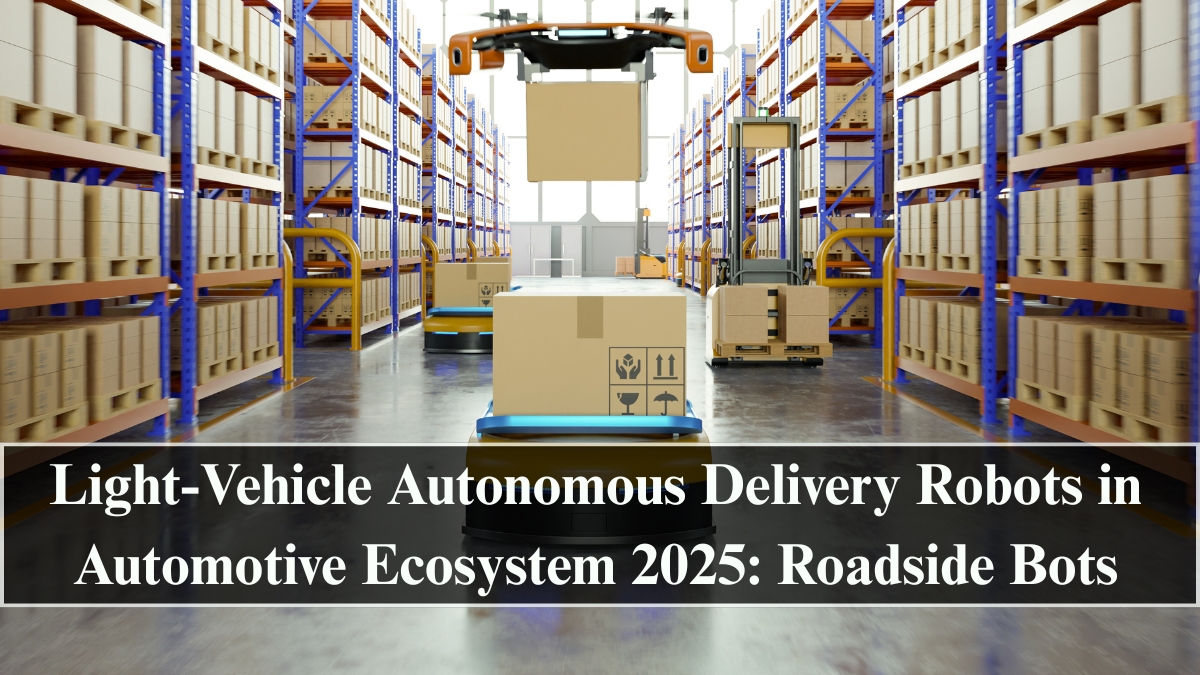In 2025, the sight of small, wheeled delivery robots quietly rolling down sidewalks and city streets is no longer futuristic — it’s everyday reality. Light-vehicle autonomous delivery robots are now an integral part of the automotive ecosystem, bridging the gap between robotics, electric mobility, and logistics automation.
These compact, driverless vehicles — often called roadside bots — are revolutionizing how goods move in urban areas. From delivering groceries to medical supplies, they represent the next leap in sustainable, efficient, and contactless delivery infrastructure powered by AI and automotive-grade safety systems.

What Are Light-Vehicle Autonomous Delivery Robots?
Light-vehicle delivery robots are small, self-driving electric vehicles designed for short-range, low-speed deliveries in cities, campuses, and industrial parks. Unlike full-sized autonomous vans or drones, these robots operate at ground level, navigating sidewalks or roadside lanes with advanced sensors and mapping software.
Key features include:
-
Lidar and 360° cameras for real-time navigation.
-
AI pathfinding algorithms to avoid obstacles and pedestrians.
-
Electric powertrains offering zero-emission operation.
-
Secure storage compartments with access codes for users.
-
Connectivity via 5G/V2X for fleet coordination and live tracking.
By combining automotive technologies like V2X communication, ADAS sensors, and EV drive systems, these robots blend the reliability of vehicles with the agility of robotics.
How They Fit into the Automotive Ecosystem
In 2025, light-vehicle delivery bots are not standalone gadgets — they’re embedded within the broader automotive and logistics ecosystem. Automakers, mobility startups, and e-commerce giants are collaborating to integrate these autonomous couriers into existing supply chains.
Key roles include:
-
Last-Mile Delivery: Transporting parcels from distribution hubs to customers’ doorsteps.
-
Campus and Hospital Logistics: Delivering meals, medicine, or documents autonomously.
-
Smart City Integration: Synchronizing with traffic systems and pedestrian zones.
-
Fleet Ecosystem Expansion: Acting as smaller, modular units linked to electric delivery vans.
In essence, they serve as the final link in a chain of connected, data-driven logistics — enhancing delivery speed and sustainability while cutting human labor costs.
Technologies Powering Roadside Bots
The success of autonomous delivery robots depends on a combination of automotive engineering, AI, and IoT infrastructure.
Core technologies include:
-
Lidar and Ultrasonic Sensors: Detect surrounding objects and measure distance precisely.
-
High-Definition Maps (HD Maps): Enable accurate positioning within centimeters.
-
AI Decision Systems: Predict pedestrian behavior and choose optimal routes.
-
Vehicle-to-Infrastructure (V2I) Communication: Interacts with traffic lights and crosswalk sensors.
-
Swappable Battery Systems: Allow continuous operation without downtime.
-
Edge Computing: Processes data locally for instant decision-making.
Many of these technologies originate from the autonomous vehicle (AV) industry, scaled down and adapted for compact delivery use.
Key Industry Players and Innovations in 2025
Major automakers and tech firms are actively investing in light-vehicle delivery robots to strengthen their last-mile logistics capabilities:
-
Toyota Woven City Project: Integrates autonomous bots for on-demand food and goods delivery.
-
Nuro R3: Licensed for commercial operation in the U.S. with full road autonomy.
-
Starship Technologies: Operating thousands of delivery bots across campuses worldwide.
-
Amazon Scout & FedEx Roxo: Use AI coordination for efficient package delivery in residential areas.
-
Hyundai MobED Platform: Modular electric base designed for customizable delivery robots.
These collaborations highlight how the automotive and robotics industries are merging, turning AI-driven logistics into a key mobility trend.
Benefits of Light-Vehicle Autonomous Delivery Robots
The rapid adoption of roadside bots is driven by clear operational and environmental advantages:
-
Lower Emissions: 100% electric systems reduce carbon footprint.
-
24/7 Operation: Continuous delivery cycles without human fatigue.
-
Reduced Traffic Congestion: Small size allows use of sidewalks or narrow lanes.
-
Cost Efficiency: Cuts delivery costs by up to 60% compared to human couriers.
-
Safety and Precision: Equipped with obstacle detection and automated braking systems.
-
Enhanced Accessibility: Ideal for contactless and last-meter deliveries in dense urban zones.
These features make them essential for smart cities, where sustainability and efficiency are top priorities.
Challenges in Scaling the Technology
Despite their promise, autonomous delivery robots face hurdles that must be addressed before large-scale adoption:
-
Regulatory Uncertainty: Varying city laws about where and how robots can operate.
-
Safety Concerns: Ensuring reliability around pedestrians, pets, and cyclists.
-
Infrastructure Gaps: Need for robot-friendly sidewalks, crossings, and charging stations.
-
Cybersecurity Risks: Protecting communication systems from interference or hacking.
-
Weather Limitations: Maintaining performance in heavy rain, snow, or heat.
Automakers and city planners are now developing standardized frameworks to regulate and monitor autonomous delivery operations globally.
The Future of Roadside Bots in Smart Mobility
By 2030, light-vehicle delivery robots are expected to become as common as food delivery bikes once were. Integration with EV infrastructure, urban IoT, and smart warehouses will make them key players in sustainable logistics.
Emerging trends include:
-
Fleet coordination via AI cloud systems for route optimization.
-
Hybrid delivery ecosystems combining drones, vans, and bots.
-
Solar-assisted micro-robots for energy autonomy.
-
Blockchain tracking for secure, transparent parcel delivery.
The convergence of robotics, mobility, and artificial intelligence is redefining not just how we drive — but how we deliver. Roadside bots are becoming the invisible workforce powering the cities of tomorrow.
FAQs
What are light-vehicle autonomous delivery robots?
They are small, self-driving electric vehicles designed for short-range deliveries, operating autonomously on sidewalks or low-speed roads.
How do these robots navigate safely?
They use lidar sensors, cameras, and AI-based pathfinding to detect obstacles and follow mapped routes in real time.
Which companies are leading in delivery robot technology?
Toyota, Nuro, Starship Technologies, Amazon, FedEx, and Hyundai are major players in the 2025 market.
What are the main advantages of autonomous delivery bots?
They provide zero-emission, low-cost, and contactless delivery services with high efficiency and safety.
What’s the future of delivery robots in smart cities?
By 2030, they will integrate with smart infrastructure and EV fleets, forming a key component of automated, sustainable logistics systems.
Click here to know more.
